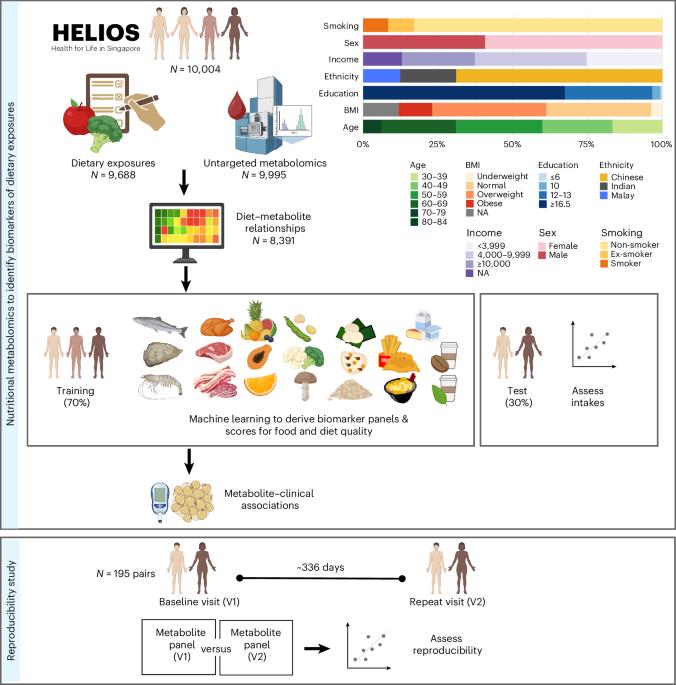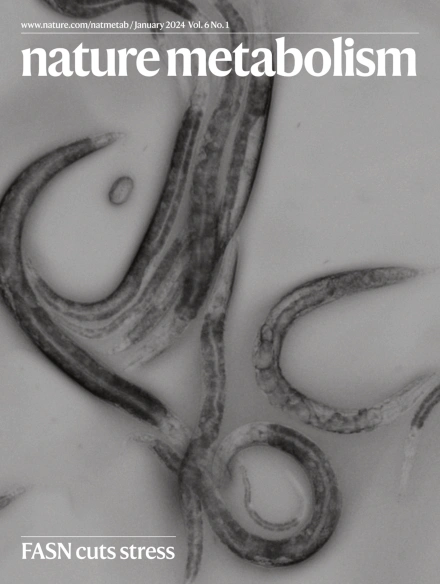代谢变异反映了多种族亚洲人群的饮食暴露。
IF 20.8
1区 医学
Q1 ENDOCRINOLOGY & METABOLISM
引用次数: 0
摘要
了解饮食如何影响不同人群的新陈代谢对于改善营养和健康至关重要。反映饮食的生物标志物主要在欧洲和美国人群中进行了探索,但食物代谢组非常复杂,并且因地区和文化而异。我们评估了8391名多种族亚洲人的1055种血浆代谢物和169种食物/饮料,并进行了饮食-代谢物关联分析。利用机器学习,我们开发了多生物标志物面板和关键食品、饮料和整体饮食质量的综合评分。本研究表明,这些生物标志物面板可用于客观评估亚洲多种族人群的饮食摄入量,并且可以比单一生物标志物更好地解释摄入预测模型的差异。与自我报告相比,已确定的饮食-代谢物关系随着时间的推移是可重复的,并且可以改善临床结果(胰岛素抵抗、糖尿病、体重指数、颈动脉内膜-中膜厚度和高血压)的预测。我们的研究结果揭示了多种族饮食相关的代谢变化,并有机会将暴露与人口健康结果联系起来。本文章由计算机程序翻译,如有差异,请以英文原文为准。

Metabolic variation reflects dietary exposure in a multi-ethnic Asian population
Understanding how diet shapes metabolism across diverse populations is essential to improving nutrition and health. Biomarkers reflecting diet are explored largely in European and American populations, but the food metabolome is highly complex and varies across region and culture. We assessed 1,055 plasma metabolites and 169 foods/beverages in 8,391 multi-ethnic Asian individuals and carried out diet–metabolite association analyses. Using machine learning, we developed multi-biomarker panels and composite scores for key foods, beverages and overall diet quality. Here we show these biomarker panels can be used to objectively assess dietary intakes in the Asian multi-ethnic population and can explain variances in intake prediction models better than single biomarkers. The identified diet–metabolite relationships are reproducible over time and improve prediction of clinical outcomes (insulin resistance, diabetes, body mass index, carotid intima-media thickness and hypertension), compared to self-reports. Our findings show insights into multi-ethnic diet-related metabolic variations and an opportunity to link exposure to population health outcomes. In a large multi-ethnic Asian cohort, associations between over 1,000 plasma metabolites and specific foods and beverages are made. These diet–metabolite relationships were used to accurately predict clinical phenotypes such as diabetes and hypertension.
求助全文
通过发布文献求助,成功后即可免费获取论文全文。
去求助
来源期刊

Nature metabolism
ENDOCRINOLOGY & METABOLISM-
CiteScore
27.50
自引率
2.40%
发文量
170
期刊介绍:
Nature Metabolism is a peer-reviewed scientific journal that covers a broad range of topics in metabolism research. It aims to advance the understanding of metabolic and homeostatic processes at a cellular and physiological level. The journal publishes research from various fields, including fundamental cell biology, basic biomedical and translational research, and integrative physiology. It focuses on how cellular metabolism affects cellular function, the physiology and homeostasis of organs and tissues, and the regulation of organismal energy homeostasis. It also investigates the molecular pathophysiology of metabolic diseases such as diabetes and obesity, as well as their treatment. Nature Metabolism follows the standards of other Nature-branded journals, with a dedicated team of professional editors, rigorous peer-review process, high standards of copy-editing and production, swift publication, and editorial independence. The journal has a high impact factor, has a certain influence in the international area, and is deeply concerned and cited by the majority of scholars.
 求助内容:
求助内容: 应助结果提醒方式:
应助结果提醒方式:


